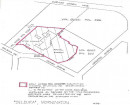Back to search results
LITTLE BENDIGO PRIMARY SCHOOL
8 MONTE STREET NERRINA, BALLARAT CITY
LITTLE BENDIGO PRIMARY SCHOOL
8 MONTE STREET NERRINA, BALLARAT CITY
All information on this page is maintained by Heritage Victoria.
Click below for their website and contact details.
Victorian Heritage Register
-
Add to tour
You must log in to do that.
-
Share
-
Shortlist place
You must log in to do that.
- Download report

Little Bendigo western elevation, 2024.








On this page:
Statement of Significance
What is significant?
Little Bendigo Primary School (Nerrina) is a picturesque brick building in a Victorian rustic Gothic style, built on foundations of bluestone, and opened in 1878 to a design by the Education Department architect H.R. Bastow. The school has a rectangular plan of one room of approximately thirteen by six metres. It has a small entrance porch facing Monte Street and a half-hipped Welsh slate gable roof with iron finials. This half hip roof form is repeated on the smaller transverse gable, and on the porch. The windows are narrow Gothic double hung sashes. The interior has a timber lined ceiling and prominent timber roof frames.
How is it significant?
Little Bendigo Primary School is of architectural significance to the State of Victoria. It satisfies the following criterion for inclusion in the Victorian Heritage Register:
Criterion A
Importance to the course, or pattern, of Victoria’s cultural history.
Criterion D
Importance in demonstrating the principal characteristics of a class of cultural places and objects.
Why is it significant?
Little Bendigo Primary School is historically significant for its representation of the prosperous early days of the town of Little Bendigo (later renamed Nerrina). Its relatively large size and sophisticated form reflects the size and the wealth of the community in the years after the discovery of gold in 1851.
(Criterion A)
Little Bendigo Primary School is architecturally significant as a surviving intact example of a small country schoolhouse, consisting of only one large room with an entry porch. It is an unusual but fine example of a picturesque Gothic school with a half-hipped gable roof, still covered with its with its original slates, and with decorative iron finials on the ridge ends.
(Criterion D)
Show more
Show less
-
-
LITTLE BENDIGO PRIMARY SCHOOL - History
Little Bendigo Primary School (also known as Primary School No. 2093) is in the Ballarat suburb of Nerrina but retains the original name of the town - Little Bendigo. The town was important both for its gold mining and for its water works used to supply and deliver water for gold sluicing.
The school’s first location was in a wooden hall attached to the St James Church of England, south of the current school site, which the Department of Education rented for £20 per annum. However, school enrolments increased dramatically through the 1870s due to the Education Act 1872 which made schooling compulsory and free. In response, the Department purchased land north of the church for a new one-room schoolhouse.
The schoolhouse was built to a design by the Education Department architect H.R. Bastow. The design was first used at Caulfield Primary School in 1877 and then applied at a number of schools including Glen Waverley (1880), Ascot (1882), Sandringham (1885) and Carlsruhe (1892). Mr Llewellyn and Mr Edwards of Ballarat East were engaged to build the schoolhouse at Little Bendigo and it opened on 9 September 1878, and catered for 138 pupils and four teachers. Whilst the example at Caulfield Primary School survives it has been extensively renovated and extended. The example in Little Bendigo, at Nerrina, built a year later, is more intact.
Little Bendigo Primary School is a picturesque brick building in a Victorian rustic Gothic style, built on foundations of bluestone said to be from the Geelong area. Its relatively large size and sophisticated form reflects the size and the wealth of the community in the years after the discovery of gold in 1851. The school has only one room, forty by twenty feet (about thirteen by six metres). It has a rectangular plan with a small entrance porch at one end. The roof is a half-hipped gable, a form which is repeated on the smaller transverse gable projecting on the west, and on the porch. The roof is clad in Welsh slate and features iron finials on all the ridge ends. The windows are narrow Gothic double hung sashes, and there are three high smaller rectangular windows under the end gables. The interior has a timber lined ceiling, and the timber roof frames are prominent. The original gallery has been removed.
As the population increased the new school building could not accommodate all enrolments and both the old premises at St James and the Methodist hall had to be leased to hold all the classes. However, soon the gold dwindled, and the population began to fall. In 1916 and 1948 the school was nearly closed due to lack of enrolments. In 1968 the student population hit an all-time low of only seven. Despite these tough times, community support ensured that Little Bendigo Primary School survived and continues to serve the local community.
Selected bibliography
Blake L J (ed) (1973) Vision and Realisation: A Centenary History of State Education in Victoria, The Government Printer, Melbourne.
Burchell L (1980) Victorian schools: a study in colonial government architecture, 1837-1900, Melbourne University Press, Melbourne.
Peterson R (1993) Historic Government Schools: a Comparative Study June 1993, Department of Planning and Development, Melbourne.
LITTLE BENDIGO PRIMARY SCHOOL - Permit Exemptions
General Exemptions:General exemptions apply to all places and objects included in the Victorian Heritage Register (VHR). General exemptions have been designed to allow everyday activities, maintenance and changes to your property, which don’t harm its cultural heritage significance, to proceed without the need to obtain approvals under the Heritage Act 2017.Places of worship: In some circumstances, you can alter a place of worship to accommodate religious practices without a permit, but you must notify the Executive Director of Heritage Victoria before you start the works or activities at least 20 business days before the works or activities are to commence.Subdivision/consolidation: Permit exemptions exist for some subdivisions and consolidations. If the subdivision or consolidation is in accordance with a planning permit granted under Part 4 of the Planning and Environment Act 1987 and the application for the planning permit was referred to the Executive Director of Heritage Victoria as a determining referral authority, a permit is not required.Specific exemptions may also apply to your registered place or object. If applicable, these are listed below. Specific exemptions are tailored to the conservation and management needs of an individual registered place or object and set out works and activities that are exempt from the requirements of a permit. Specific exemptions prevail if they conflict with general exemptions. Find out more about heritage permit exemptions here.Specific Exemptions:Specific Exemptions
The works and activities below are not considered to cause harm to the cultural heritage significance of the Place or object name subject to the following guidelines and conditions:
Guidelines- Where there is an inconsistency between permit exemptions specific to the registered place or object (‘specific exemptions’) established in accordance with either section 49(3) or section 92(3) of the Act and general exemptions established in accordance with section 92(1) of the Act specific exemptions will prevail to the extent of any inconsistency.
- In specific exemptions, words have the same meaning as in the Act, unless otherwise indicated. Where there is an inconsistency between specific exemptions and the Act, the Act will prevail to the extent of any inconsistency.
- Nothing in specific exemptions obviates the responsibility of a proponent to obtain the consent of the owner of the registered place or object, or if the registered place or object is situated on Crown Land the land manager as defined in the Crown Land (Reserves) Act 1978, prior to undertaking works or activities in accordance with specific exemptions.
- If a Cultural Heritage Management Plan in accordance with the Aboriginal Heritage Act 2006 is required for works covered by specific exemptions, specific exemptions will apply only if the Cultural Heritage Management Plan has been approved prior to works or activities commencing. Where there is an inconsistency between specific exemptions and a Cultural Heritage Management Plan for the relevant works and activities, Heritage Victoria must be contacted for advice on the appropriate approval pathway.
- Specific exemptions do not constitute approvals, authorisations or exemptions under any other legislation, Local Government, State Government or Commonwealth Government requirements, including but not limited to the Planning and Environment Act 1987, the Aboriginal Heritage Act 2006, and the Environment Protection and Biodiversity Conservation Act 1999 (Cth). Nothing in this declaration exempts owners or their agents from the responsibility to obtain relevant planning, building or environmental approvals from the responsible authority where applicable.
- Care should be taken when working with heritage buildings and objects, as historic fabric may contain dangerous and poisonous materials (for example lead paint and asbestos). Appropriate personal protective equipment should be worn at all times. If you are unsure, seek advice from a qualified heritage architect, heritage consultant or local Council heritage advisor.
- The presence of unsafe materials (for example asbestos, lead paint etc) at a registered place or object does not automatically exempt remedial works or activities in accordance with this category. Approvals under Part 5 of the Heritage Act 2017 must be obtained to undertake works or activities that are not expressly exempted by the below specific exemptions.
- All works should be informed by a Conservation Management Plan prepared for the place or object. The Executive Director is not bound by any Conservation Management Plan and permits still must be obtained for works suggested in any Conservation Management Plan.
Conditions- All works or activities permitted under specific exemptions must be planned and carried out in a manner which prevents harm to the registered place or object.?Harm includes moving, removing or damaging any part of the registered place or object that contributes to its cultural heritage significance.
- during the carrying out of works or activities in accordance with specific exemptions original or previously hidden or inaccessible details of the registered place are revealed relating to its cultural heritage significance, including but not limited to historical archaeological remains, such as features, deposits or artefacts, then works must cease and Heritage Victoria notified as soon as possible.
- If during the carrying out of works or activities in accordance with specific exemptions any Aboriginal cultural heritage is discovered or exposed at any time, all works must cease and the Secretary (as defined in the Aboriginal Heritage Act 2006) must be contacted immediately to ascertain requirements under the Aboriginal Heritage Act 2006.
- If during the carrying out of works or activities in accordance with specific exemptions any munitions or other potentially explosive artefacts are discovered, Victoria Police is to be immediately alerted and the site is to be immediately cleared of all personnel.
- If during the carrying out of works or activities in accordance with specific exemptions any suspected human remains are found the works or activities must cease. The remains must be left in place and protected from harm or damage. Victoria Police and the State Coroner’s Office must be notified immediately. If there are reasonable grounds to believe that the remains are Aboriginal, the State Emergency Control Centre must be immediately notified on 1300 888 544, and, as required under s.17(3)(b) of the Aboriginal Heritage Act 2006, all details about the location and nature of the human remains must be provided to the Secretary (as defined in the Aboriginal Heritage Act 2006.
Exempt works and activities- All buildings constructed or moved to the site post 1900
- All internal works.
- Removal or demolition.
- Landscape/ outdoor areas
- Replacement of playground equipment and outdoor furniture in the same location.
- Pruning of all trees to ensure safety.
- Removal, replacement and installation of new ground surfacing treatments (for example, asphalt, safety matting) provided it is not within five metres of the significant building.
LITTLE BENDIGO PRIMARY SCHOOL - Permit Exemption Policy
It is recommended that a Conservation Management Plan is utilised to manage the place/object type in a manner which respects its cultural heritage significance.
-
-
-
-
-
TEMPERANCE MINE SITE AND HEAD OF EUREKA LEAD
 Victorian Heritage Inventory
Victorian Heritage Inventory -
FORMER EUREKA LEAD GOLD SLUICING COMPANY PUMP SHED
 Victorian Heritage Inventory
Victorian Heritage Inventory -
Former St James' Church of England
 National Trust
National Trust
-
177 Fenwick Street
 Yarra City
Yarra City -
19 Cambridge Street
 Yarra City
Yarra City -
2 Derby Street
 Yarra City
Yarra City
-
-










